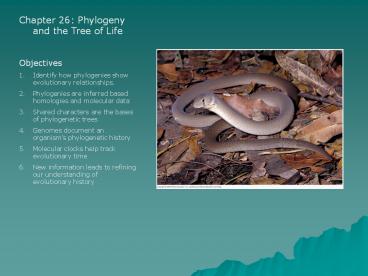Chapter 26: Phylogeny and the Tree of Life PowerPoint PPT Presentation
Title: Chapter 26: Phylogeny and the Tree of Life
1
- Chapter 26 Phylogeny and the Tree of Life
- Objectives
- Identify how phylogenies show evolutionary
relationships. - Phylogenies are inferred based homologies and
molecular data - Shared characters are the bases of phylogenetic
trees - Genomes document an organisms phylogenetic
history - Molecular clocks help track evolutionary time
- New information leads to refining our
understanding of evolutionary history
2
Evolutionary Trees are based on
Phylogenies -Phylogeny is the evolutionary
history of a species -Taxonomy is the study that
focuses on classification -Use of a Hierarchy -
Uses of Binomial Nomenclature -Started by Carl
Linnaeus Link between phylogenies and
classification
Specific
General
3
Unresolved
- Conclusions
- No assumptions about time or genetic change ONLY
on patterns of descent. - Cant assume organisms evolved from the organism
next to it only that they had a common ancestor.
4
Morphological Homologies and Analogies -In
general the more similar morphologies the closer
the species are related. -Analogous structures
come from convergent evolution. (Similar
environmental factors favor similar
phenotypes) -Homologous structures have
evolutionary link.
Molecular homologies are difficult to detect -
Use of computer software to detect homologous
areas of DNA
5
Cladistics Systematics that uses common ancestry
as primary way to classify organisms
Clade that includes ancstor and all its
descendents.
Clade that includes descendents from two or more
common ancestors
Clade that includes ancstor and some of its
descendents.
Which is considered a shared ancestral
character? Which is considered a derived
character? What is the purpose of an outgroup?
6
Phylogenetic Trees are Hypothesis So?
Based on Maximum Parisomy or the least amount of
evolutionary events measured by observed derived
characteristics
Hypothesis allow for predictions about past and
future
7
- Genomic Homologies
- Mainly caused by duplication, which allows for
increased amount of biochemical opportunities - Orthologous Genes Homologous genes found in
different species - Paralogous Genes Gene duplication within a
species - Genome Comparison
- 99 of human and mice genomes are Orthologous
- Phenotypic changes seem to increase at a faster
rate then the duplication rate.
8
- Molecular Clocks
- Measurement of time that relies on the constant
rates of gene evolution. - The longer ago the divergence time the more
mutations have occurred - Can be used to date the origin of diseases like
HIV (p. 551)
9
Understanding of life and classification has
changed based on new knowledge -Euglena -Prokaryo
tic differences
Horizontal Gene Transfer -Gene transfer through
other methods such as viral infection or fusion
of organisms

